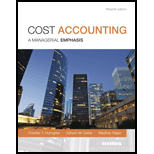
1.
The division margin in terms of percentage before allocation of fixed
Given
Hotel revenue as $16,425,000
Restaurant revenue as $5,256,000
Casino Revenues $12,340,000
Direct costs of hotel as $9,819,260
Direct costs of restaurant $3,749,172
Direct costs of casino as 4,248,768
Segment margin of hotel as $ 6,605,740
Segment margin of restaurant as $1,506,828
Segment margin of casino as $ 8,091,232
Floor space of hotel as 80,000 sqft
Floor space of restaurant 16,000 sqft
Floor space of casino as 64,000 sqft
No. of employees in hotel as 200
No. of employees in restaurant as 50
No. of employees in casino as 250
Total fixed overhead costs for 2013 were $14,550,000
2.
The allocation of indirect costs to divisions using three different bases suggested.
3.
The way to decide how to allocate the indirect costs to the division
4.
Whether any of the divisions should be closed on the basis of the analysis
Want to see the full answer?
Check out a sample textbook solution
Chapter 14 Solutions
Cost Accounting, Student Value Edition (15th Edition)
- Solve and show work.arrow_forwardSolve this without ai plarrow_forwardLast year, Parker Industries' cash account decreased by $22,000. Net cash provided by investing activities was $18,000, and net cash used in financing activities was $12,000. What was the net cash flow provided by (used in) operating activities on the statement of cash flows?arrow_forward
- I need guidance with this general accounting problem using the right accounting principles.arrow_forwardPlease see an attachment for details the general accounting question with step by step explanationarrow_forwardCan you explain the correct methodology to solve this general accounting problem?arrow_forward

 AccountingAccountingISBN:9781337272094Author:WARREN, Carl S., Reeve, James M., Duchac, Jonathan E.Publisher:Cengage Learning,
AccountingAccountingISBN:9781337272094Author:WARREN, Carl S., Reeve, James M., Duchac, Jonathan E.Publisher:Cengage Learning, Accounting Information SystemsAccountingISBN:9781337619202Author:Hall, James A.Publisher:Cengage Learning,
Accounting Information SystemsAccountingISBN:9781337619202Author:Hall, James A.Publisher:Cengage Learning, Horngren's Cost Accounting: A Managerial Emphasis...AccountingISBN:9780134475585Author:Srikant M. Datar, Madhav V. RajanPublisher:PEARSON
Horngren's Cost Accounting: A Managerial Emphasis...AccountingISBN:9780134475585Author:Srikant M. Datar, Madhav V. RajanPublisher:PEARSON Intermediate AccountingAccountingISBN:9781259722660Author:J. David Spiceland, Mark W. Nelson, Wayne M ThomasPublisher:McGraw-Hill Education
Intermediate AccountingAccountingISBN:9781259722660Author:J. David Spiceland, Mark W. Nelson, Wayne M ThomasPublisher:McGraw-Hill Education Financial and Managerial AccountingAccountingISBN:9781259726705Author:John J Wild, Ken W. Shaw, Barbara Chiappetta Fundamental Accounting PrinciplesPublisher:McGraw-Hill Education
Financial and Managerial AccountingAccountingISBN:9781259726705Author:John J Wild, Ken W. Shaw, Barbara Chiappetta Fundamental Accounting PrinciplesPublisher:McGraw-Hill Education





